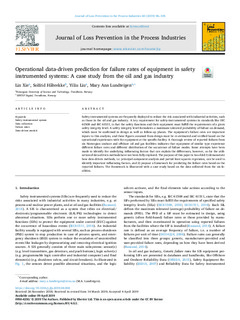| dc.contributor.author | Xie, Lin | |
| dc.contributor.author | Håbrekke, Solfrid | |
| dc.contributor.author | Liu, Yiliu | |
| dc.contributor.author | Lundteigen, Mary Ann | |
| dc.date.accessioned | 2019-12-16T14:29:19Z | |
| dc.date.available | 2019-12-16T14:29:19Z | |
| dc.date.created | 2019-06-18T13:00:35Z | |
| dc.date.issued | 2019 | |
| dc.identifier.citation | Journal of Loss Prevention in the Process Industries. 2019, 60 96-105. | nb_NO |
| dc.identifier.issn | 0950-4230 | |
| dc.identifier.uri | http://hdl.handle.net/11250/2633466 | |
| dc.description.abstract | Safety instrumented systems are frequently deployed to reduce the risk associated with industrial activities, such as those in the oil and gas industry. A key requirement for safety-instrumented systems in standards like IEC 61508 and IEC 61511, is that the safety functions and their equipment must fulfill the requirements of a given safety integrity level. A safety integrity level formulates a maximum tolerated probability of failure on demand, which must be confirmed in design as well as follow-up phases. The equipment's failure rates are important inputs to this analysis, and these figures assumed from design must be re-estimated and verified based on the operational experiences with the equipment at the specific facility. A thorough review of reported failures from six Norwegian onshore and offshore oil and gas facilities indicates that equipment of similar type experience different failure rates and different distribution of the occurrence of failure modes. Some attempts have been made to identify the underlying influencing factors that can explain the differences, however, so far the utilization of data-driven methods have not been fully explored. The purpose of this paper is two-fold:1) demonstrate how data-driven methods, i.e. principal component analysis and partial least squares regression, can be used to identify important influencing factors, and 2) propose a framework for predicting the failure rates based on the reported failures. The framework is illustrated with a case study based on the data collected from the six facilities. | nb_NO |
| dc.language.iso | eng | nb_NO |
| dc.publisher | Elsevier | nb_NO |
| dc.rights | Navngivelse 4.0 Internasjonal | * |
| dc.rights.uri | http://creativecommons.org/licenses/by/4.0/deed.no | * |
| dc.title | Operational data-driven prediction for failure rates of equipment in safety instrumented systems: A case study from the oil and gas industry | nb_NO |
| dc.type | Journal article | nb_NO |
| dc.type | Peer reviewed | nb_NO |
| dc.description.version | publishedVersion | nb_NO |
| dc.source.pagenumber | 96-105 | nb_NO |
| dc.source.volume | 60 | nb_NO |
| dc.source.journal | Journal of Loss Prevention in the Process Industries | nb_NO |
| dc.identifier.doi | 10.1016/j.jlp.2019.04.004 | |
| dc.identifier.cristin | 1705683 | |
| dc.description.localcode | 2019 The Authors. Published by Elsevier Ltd. This is an open access article under the CC BY license (http://creativecommons.org/licenses/BY/4.0/). | nb_NO |
| cristin.unitcode | 194,64,92,0 | |
| cristin.unitname | Institutt for maskinteknikk og produksjon | |
| cristin.ispublished | true | |
| cristin.fulltext | original | |
| cristin.qualitycode | 1 | |

